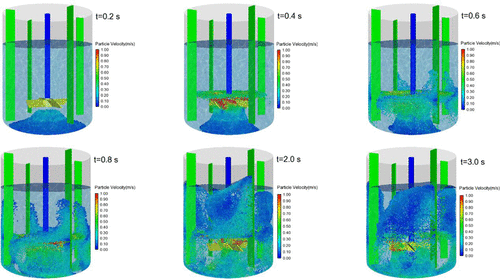当前位置:
X-MOL 学术
›
Ind. Eng. Chem. Res.
›
论文详情
Our official English website, www.x-mol.net, welcomes your
feedback! (Note: you will need to create a separate account there.)
Development of a DEM–VOF Model for the Turbulent Free-Surface Flows with Particles and Its Application to Stirred Mixing System
Industrial & Engineering Chemistry Research ( IF 3.8 ) Pub Date : 2018-01-26 00:00:00 , DOI: 10.1021/acs.iecr.7b04833 Liang Wu 1 , Ming Gong 2 , Jingtao Wang 1
Industrial & Engineering Chemistry Research ( IF 3.8 ) Pub Date : 2018-01-26 00:00:00 , DOI: 10.1021/acs.iecr.7b04833 Liang Wu 1 , Ming Gong 2 , Jingtao Wang 1
Affiliation

|
The free-surface flows with particles are widely found in chemical engineering, and numerical modeling is a strong computing tool for in-depth understanding of the local and macrocharacteristics. In this study, a discrete element method–volume-of-fluid (DEM–VOF) model is extended to turbulent free-surface flows with particles, by means of Reynolds stress model. Also, we adopt a novel virtual dual-grid porosity model to calculate the fluid porosity. The simulated results of single particle sedimentation, the falling of sinking particles, and the floating of buoyant particles agree well to analytical and literatures, which validate the proposed DEM–VOF model. Furthermore, the DEM–VOF model developed in this paper is applied to the simulation of free surface flow with particles in solid–liquid mixing system for the first time. It is found that elliptical-head vessel is preferred to a flat-bottomed vessel for solid–liquid mixing by comparing the simulation results of four different stirred tanks, which agrees well to the related content of the book Handbook of Industrial Mixing (Paul, E. L.; Atiemo-Obeng, V. A.; Kresta, S. M. Eds.; John Wiley & Sons, 2004).
中文翻译:

带有颗粒的湍流自由表面流的DEM–VOF模型的开发及其在搅拌混合系统中的应用
在化学工程中广泛发现带有颗粒的自由表面流,而数值模型是深入了解局部和宏观特征的强大计算工具。在这项研究中,借助雷诺应力模型,将离散元素方法-流体体积(DEM-VOF)模型扩展到带有颗粒的湍流自由表面流。此外,我们采用一种新颖的虚拟双网格孔隙度模型来计算流体孔隙度。单颗粒沉降,下沉颗粒的下落和浮力颗粒的漂浮的模拟结果与分析和文献相吻合,从而验证了所提出的DEM–VOF模型。此外,本文开发的DEM–VOF模型首次应用于固液混合系统中带有颗粒的自由表面流的模拟。工业混合手册(Paul,EL; Atiemo-Obeng,VA; Kresta,SM Eds .; John Wiley&Sons,2004)。
更新日期:2018-01-27
中文翻译:

带有颗粒的湍流自由表面流的DEM–VOF模型的开发及其在搅拌混合系统中的应用
在化学工程中广泛发现带有颗粒的自由表面流,而数值模型是深入了解局部和宏观特征的强大计算工具。在这项研究中,借助雷诺应力模型,将离散元素方法-流体体积(DEM-VOF)模型扩展到带有颗粒的湍流自由表面流。此外,我们采用一种新颖的虚拟双网格孔隙度模型来计算流体孔隙度。单颗粒沉降,下沉颗粒的下落和浮力颗粒的漂浮的模拟结果与分析和文献相吻合,从而验证了所提出的DEM–VOF模型。此外,本文开发的DEM–VOF模型首次应用于固液混合系统中带有颗粒的自由表面流的模拟。工业混合手册(Paul,EL; Atiemo-Obeng,VA; Kresta,SM Eds .; John Wiley&Sons,2004)。









































 京公网安备 11010802027423号
京公网安备 11010802027423号